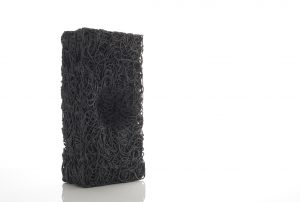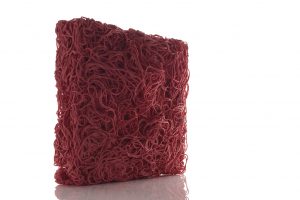Landon Peck
The winner of the Henry Rothschild Ceramic Bursary in 2014 was Landon Peck.
I am drawn to working with clay because of the almost unruly characteristic of ceramic alchemy. As much as I strive to control its transformation, clay is almost always unpredictable. Every firing produces a result from which I learn and record, providing fresh discoveries and, frequently, another mystery. It is this enigmatic quality of clay and its constituents that transfixes me.
Beyond its inherent physical properties, clay is also an effective metaphor. For me it represents complex human motivations and preoccupations: eternal conflicts, the impulse to question, understand, adjust, review, evaluate, reform, and resolve. It symbolises our changeable dispositions. As much as we may strive, through education and preparation, to exert agency and control over what lies before us, clay teaches us that this can only ever be partial. Its final articulation after firing is often, while not necessarily unsatisfying, unexpected.
This provides an effective analogy for the cycle of transitions we go through in life – our rites of passage. My journey with clay – from formulating my initial intentions to their final manifestation – is an exploration of the physical and formal, but also the metaphysical. It is a relationship with matter that I find compelling.
The first creative project I undertook after being awarded the Henry Rothschild Ceramic Bursary was in collaboration with AbbVie Pharmaceuticals, raising awareness of hepatitis C. Art, Liver Disease and Me involved interviewing and working with Max, who had unknowingly lived with the disease for almost 20 years.
As someone who also lives with stigmatised conditions (HIV and diabetes), I was able to empathise with him and exchange in a very real way. Max’s struggle to accommodate a traumatic diagnosis, self-perception, its life-long health implications, adjustment, depression and the stigmas typically associated with such diseases and disabilities paralleled mine. The three-month project and resulting work, I’ll Take The Blue Pill, catalysed a renewed interest in ceramics as a vernacular that can embody social preoccupations and promote awareness of them.
The Bursary subsequently enabled and facilitated a two-year research project investigating a process of casting medium to large dense ceramic structures using a disposable armature system. Unsolid Matter is a new body of work that emerged from my research, and was inspired by human anatomy, its architecture, inherent strength, frailty and propensity to cope with change. Unsolid Matter is a series of seemingly solid, geometric matrix forms composed of hundreds of bone china capillaries, cast within a controlled environment (the mould itself) but which then distort and reshape when fired. Brittle but fragile to the touch, they represent the physical and mental anxieties associated with the human body.
Receiving a Henry Rothschild Ceramic Bursary has been transformative. It made possible research and making that led to several significant bodies of work of a sophistication and complexity that I could not have achieved otherwise. It has, in addition, facilitated professional development and an enduring relationship with the University of Hertfordshire.
With the endorsement of the Henry Rothschild Ceramic Bursary, I successfully applied to the University’s AA2A programme to realise the project that led to Unsolid Matter. Through AA2A I was able to work closely with undergraduates on their own projects, as well as my own. Having demonstrated my knowledge, and technical and communication skills, I went on to be offered the position of Ceramics Tutor on the University’s Design Crafts programme. I still hold this post, which continues to provide me with a livelihood and an inspiring and thought-provoking workplace.
I cannot thank the trustees of the Bursary enough for the many positive ways in which receiving a Henry Rothschild Ceramic Bursary has impacted on my life and enhanced my creative practice.


 This provides an effective analogy for the cycle of transitions we go through in life – our rites of passage. My journey with clay – from formulating my initial intentions to their final manifestation – is an exploration of the physical and formal, but also the metaphysical. It is a relationship with matter that I find compelling.
This provides an effective analogy for the cycle of transitions we go through in life – our rites of passage. My journey with clay – from formulating my initial intentions to their final manifestation – is an exploration of the physical and formal, but also the metaphysical. It is a relationship with matter that I find compelling. The Bursary subsequently enabled and facilitated a two-year research project investigating a process of casting medium to large dense ceramic structures using a disposable armature system. Unsolid Matter is a new body of work that emerged from my research, and was inspired by human anatomy, its architecture, inherent strength, frailty and propensity to cope with change. Unsolid Matter is a series of seemingly solid, geometric matrix forms composed of hundreds of bone china capillaries, cast within a controlled environment (the mould itself) but which then distort and reshape when fired. Brittle but fragile to the touch, they represent the physical and mental anxieties associated with the human body.
The Bursary subsequently enabled and facilitated a two-year research project investigating a process of casting medium to large dense ceramic structures using a disposable armature system. Unsolid Matter is a new body of work that emerged from my research, and was inspired by human anatomy, its architecture, inherent strength, frailty and propensity to cope with change. Unsolid Matter is a series of seemingly solid, geometric matrix forms composed of hundreds of bone china capillaries, cast within a controlled environment (the mould itself) but which then distort and reshape when fired. Brittle but fragile to the touch, they represent the physical and mental anxieties associated with the human body. With the endorsement of the Henry Rothschild Ceramic Bursary, I successfully applied to the University’s AA2A programme to realise the project that led to Unsolid Matter. Through AA2A I was able to work closely with undergraduates on their own projects, as well as my own. Having demonstrated my knowledge, and technical and communication skills, I went on to be offered the position of Ceramics Tutor on the University’s Design Crafts programme. I still hold this post, which continues to provide me with a livelihood and an inspiring and thought-provoking workplace.
With the endorsement of the Henry Rothschild Ceramic Bursary, I successfully applied to the University’s AA2A programme to realise the project that led to Unsolid Matter. Through AA2A I was able to work closely with undergraduates on their own projects, as well as my own. Having demonstrated my knowledge, and technical and communication skills, I went on to be offered the position of Ceramics Tutor on the University’s Design Crafts programme. I still hold this post, which continues to provide me with a livelihood and an inspiring and thought-provoking workplace.